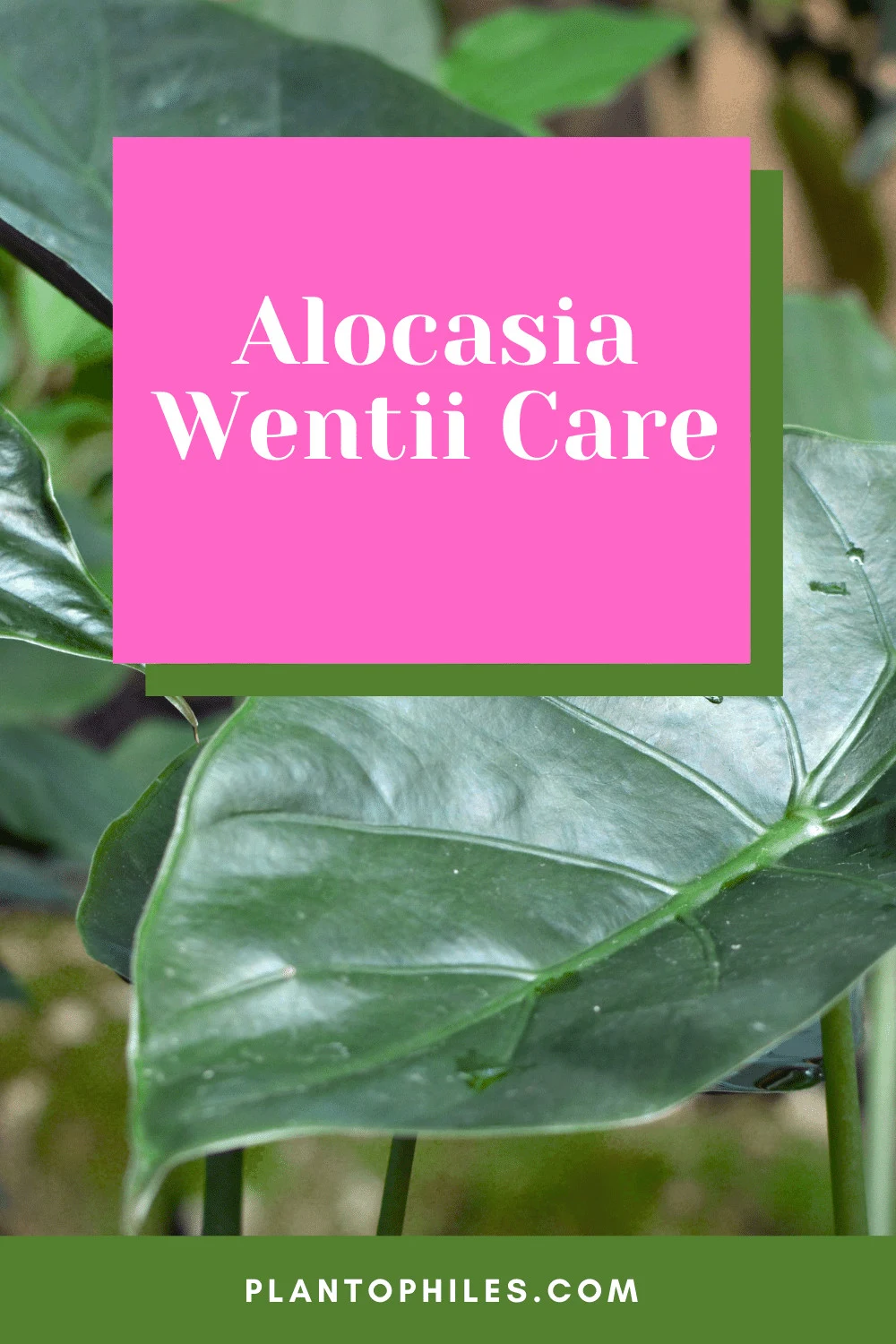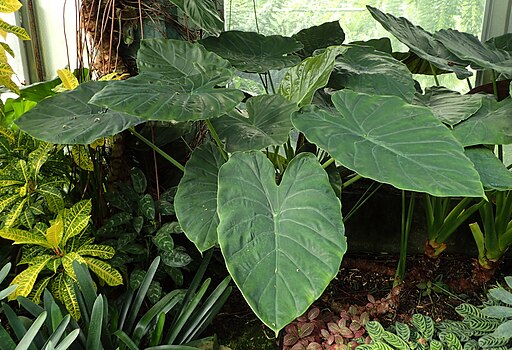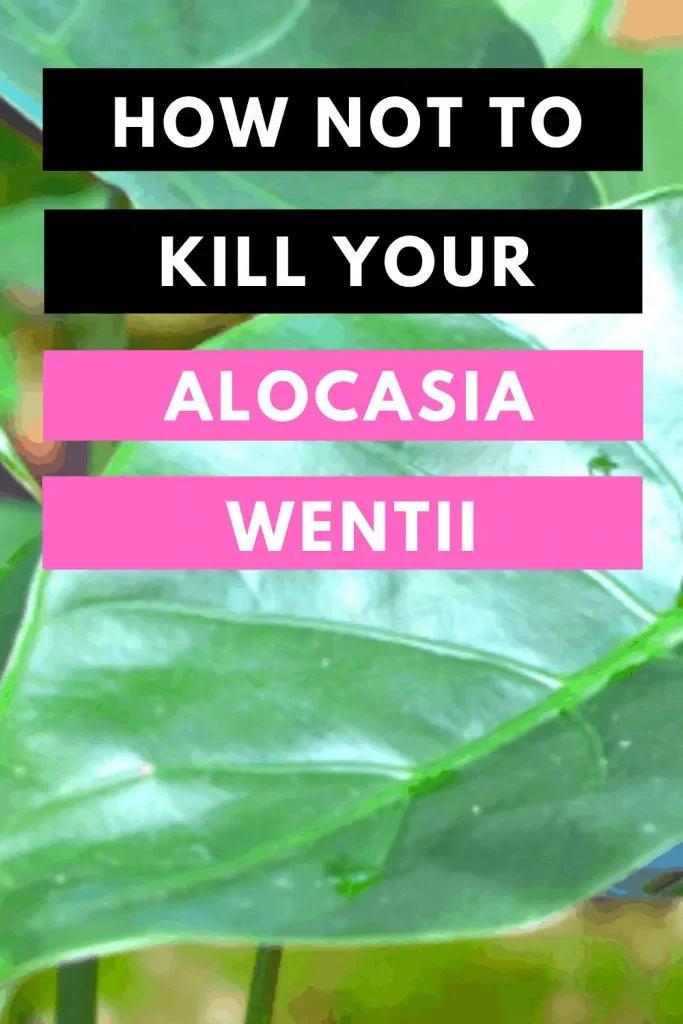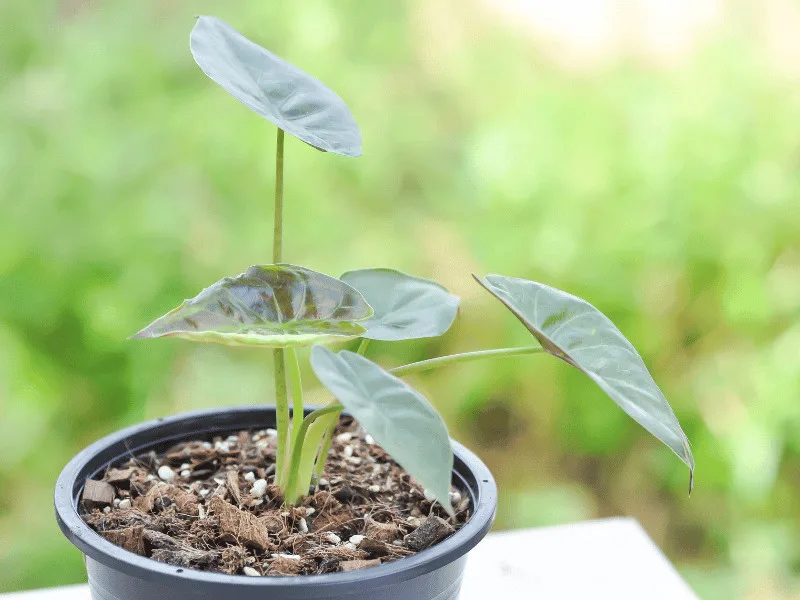The Alocasia wentii, commonly known as ‘Hardy Elephant Ears,’ is an excellent houseplant choice for numerous reasons. However, the foremost reason is its unique green and purple foliage.
Yet another names is New Guinea Shield for this hardy perennial. Alocasia wentii grows tubers underneath the soil and can grow up to 32” inches (0.8m), according to NC State University.
Alocasia wentii Takeaways
| Species | Alocasia wentii |
| Synonyms | Elephant Ear, Alocasia wentii, A. wentii, Went's Elephant Ear |
| Family | Araceae |
| Genus | Alocasia |
| Growth | Compact, Clumping |
| Height | 3 feet |
| Width | 2 feet |
| Soil | Well-draining soil mix |
| Watering | Every 5-7 days |
| Light | Bright Indirect |
| Temperature | 65-80 °F (18-27 °C) |
| Humidity | 50-70% |
| Fertilizer | Fertilize monthly in spring and summer |
| Propagation | By division |
| Toxicity | Toxic to animals such as cats and dogs, and humans. Contains calcium oxalate crystals. Can cause mouth pain, nausea, vomiting, and diarrhea. |
Table of Contents
Alocasia wentii Care
To care for Alocasia wentii provide bright indirect light and a well-draining potting mix that stays slightly moist. Water once weekly when the top 1-2” soil is almost dry (2.5-5cm). Provide a temperature between 60 to 86 degrees Fahrenheit (16 to 30 degrees Celsius). The ideal humidity level is higher than 60%. Fertilize every two weeks during spring and summer using a liquid fertilizer.

What is the Alocasia wentii Plant?
The exotic Wentii plant species have large arrowhead-shaped leaves with a unique color combination. The topsides are a deep shade of green, while the undersides are colored a metallic bronzy purple. Its exceptional foliage makes it a top favorite of several houseplant owners.
An interesting fact about the Alocasia wentii is that it is an artificial crossbreed between Alocasia Odora and Alocasia Gageana. It is extensively grown in Southeast Asia and is widely known for its ornamental appearance. A. wentii are tropical rainforest plants.

Caring for an Alocasia wentii

Soil
The Alocasia wentii plant loves moist, well-draining, and nutrient-rich soil. It loves potting mixtures that retain moisture and are well-aerated.
Avoid compacted, dense soil. Roots need oxygen.
I recommend using a porous potting mix: one part soil, one part coarse potting sand or perlite, and lastly, one part peat. Ensure the plant’s soil is sufficiently moist at all times but not completely water-saturated. The soils that are excessively wet increase the probability of infection.
I do not use spagnum moss in my potting mix for this very reason. Moss is great for plant propagation but not so much as part of a mix. It keeps the soil too wet.
The ideal pH for your lovely Alocasia went plant is 5-8 (acidic to slightly alkaline). Growing your plant at its desired pH will help you have unrestricted access to the necessary nutrients. However, ensure it does not contain too many minerals, such as Calcium and Aluminum, as they may cause toxicity.

Watering
Water Alocasia wentii once the top 1-2 inches of soil become almost dry (2.5-5cm) about once a week.
This attractive beauty has regular watering needs. For the healthy development of the Alocasia wentii, it is necessary to establish a good balance between under and overwatering.
To keep your Went’s Elephant Ear happy and healthy, water it moderately. I suggest you wait for your Alocasia wentii plant’s soil top 1 to 2 inches to dry before you water it (2.5-5cm). This will minimize the possibility of the plant catching any fungal infections. Water the plant evenly so that the moisture reaches all parts.
Watering once or twice a week is optimal during the summer and spring growing seasons. However, your plant’s watering needs may change during the winter season when the plant is not actively growing or dormant.
In the winter, watering once a week is adequate. Alternatively, let the Alocasia wentii plant’s soil be your guide and water accordingly.
Like all other plants, Alocasias are sensitive to under and overwatering. Therefore, they may wilt or die when any of the two conditions occur. Fungal infections can be present as root-rot or discolored or yellow leaves.
The easy prevention for all these problems is need-based watering. Water only when needed. I recommend you use chlorine-free water to minimize the possibility of toxicity. It will also generally help the plant grow better.
Alocasia wentii Light
The Alocasia wentii plant requires bright dappled sunlight. Also, it is best to keep the Wentii plant away from direct scorching sun rays.
Place your Alocasia wentii plant in a spot where indirect, filtered light hits it. This is alo referrred to as bright indirect light. I suggest you place your Wentii plant next to a window with filtered light.
Generally, south-west facing windows offer the perfect light for such plants. You can also hang it from a basket just inside your balcony door as an alternate option.
If there is no such spot in the house, do not worry. You can also use artificial growing lights for your beautiful Alocasia wentii plant.
The Alocasia wentii plant’s leaf undersides are mostly purple. Thus, they have a low tolerance to sunlight.
Insufficient light will lead to stunted growth. On the other hand, excessive direct sunlight will lead to scorching leaves. Therefore, please keep your Alocasia Wendii in the right lighting conditions.
Temperature
Alocasia wentii plant’s ideal temperature range during the day is 60 to 86 degrees Fahrenheit (16 to 30 degrees Celsius). At night, it prefers temperatures ranging from 54 to 64 degrees Fahrenheit (12 to 17 degrees Celsius). The maximum temperature tolerable is 95 degrees Fahrenheit (35 degrees Celsius).
The tropical Alocasia wentii thrives in mild to moderate temperatures. Fortunately, it is not too temperature sensitive and can tolerate a considerable range of temperatures.
Luckily, typical households fall within this range of temperatures. This makes the Alocasia wentii an excellent houseplant choice. One suggestion for a happy Wentii plant is to avoid direct wind drafts from open windows, air conditioners, or heaters.
However, if you are a resident of extreme temperature areas, it might be harder to maintain the Wentii plant’s desired temperature needs.
One option is to bring the plant inside if it is too hot or cold. You can also place your Wentii plant close to heaters or fans if it is excessively chilly or warm, respectively.
Please be sure not to expose your Elephant ear plant to freezing temperatures as in such conditions, it can lose all its leaves and die.
Humidity
The lovely Alocasia wentii is a humidity lover. It enjoys growing in humid environments, as is expected from its tropical species. The Wentii plant does exceptionally well when placed in 60% to 80% humidity.
These high humidity levels might arise as a problem, as humidity greater than 50% can be uncomfortable in an average household. Thankfully, there are several natural and artificial ways for you to establish the Wentii plant’s required humidity levels.
For a humid environment, you can group your houseplants in one room. Alternatively, you can place your Alocasia wentii plant on a tray full of water and pebbles. You can also buy a humidifier and mimic the plant’s desired humidity in your house.
Moreover, you can mist the plant’s surroundings for even humidity distribution. However, ensure that you do not directly spray the plant’s leaves. An excessively wet plant is more likely to be infected by diseases and pests.
Fertilizer
Fertilize Alocasia wentii every two weeks in spring and summer using a balanced liquid fertilizer. Alocasias are heavy feeders. They go into dormancy in autumn and winter. Reduce or refrain from feeding your plant in autumn and winter.
The lovely Alocasias are heavy feeders. To keep up with their growth, you must often feed them with their preferred fertilizer.
The Alocasia wentii plant likes to be fed every two to four weeks with a good-quality fertilizer that contains optimum levels of nitrogen, phosphate, and potassium. You can use diluted liquid fertilizer or slow-release fertilizer.
If you use liquid fertilizer, feed the plant after two to four weeks. In the case of slow-release fertilizer, feeding the plant twice a month is sufficient.
The Alocasia wentii plant should be kept well-fed, especially during the growing summer seasons. Feeding the plant during the winter season is not necessary. Fertilizing it during this time may lead to salt-buildup and significant damage, such as burnt leaf tips.
Repotting
Alocasia wentii does not have to be repotted often and likes to be root-bound. Repot this Alocasia after the first year. Use a pot with drainage holes so water can drain.
The Alocasia wentii has beautiful and lush foliage. Potting it in fancy containers and decorative baskets adds to its charm. Luckily, the Wentii plant does not require repotting often.
Surprisingly, Alocasias like to be root-bound. Therefore, you do not need to repot it every few months. I recommend you repot your Wentii plant after a year.
The new pot does not necessarily have to be very big as it may loosen the roots too much and adversely affect the Wentii plant’s growth. It is best to choose a container that fits its roots.
Repotting your Alocasia wentii plant at the start of the growing season is ideal. This will help the plant grow better and healthier. Please avoid repotting during the dormant winter seasons.
Pruning
Maintenance of most plants requires pruning. Similarly, the Alocasia wentii plant also requires some cutting occasionally. Though beautiful, if left uncared for, it can begin to look unruly and unattractive.
There can be several reasons to prune an Alocasia wentii plant. One cause is mere size control. If you think your plant is taking too much space or would like it to be smaller, grab a pair of pruning shears and carefully cut off a few vines.
Likewise, yellow leaves can make any plant look dull and unpleasant. Therefore, remove the leaves that seem dead or old to you. Alternatively, if a leaf or vine is infected with fungus or disease, cut it off.
Letting diseased or fungal-infected leaves grow may lead to the spread of infection, ruining the plant entirely. Please remember that it is better to cut the bottom leaves of the Wentii plant as new leaves often develop at the top.
For extra care, sterilize your gardening and plant equipment before using it on any plants. This will further minimize the probability of the spread of disease.
Alocasia wentii Propagation
Alocasia wentii is propagated from tubers. Tubers are also called bulbs. New pups start growingout of the pot automatically and can be cut off the motherplant.
Fortunately, propagating an Alocasia wentii plant is not much of a challenge. Most of the Alocasia plants are tuberous species, meaning they sprout from a central rhizome.
The Alocasia wentii plant often produces off of itself, making propagation much easier. The baby plants grow from the parent plant’s roots that can later be separated and developed as an individual plant.
Rhizome Method
For this, you will need a healthy Alocasia wentii plant, some scissors, a pre-prepared potting mix, and some water. I also suggest you wear protective clothing.
- Prepare a potting mix and add some water. Alternatively water propagation works as well
- Carefully remove the Wentii plant from its pot and shake off the excess soil stuck to its roots. Use a gardening hose if required for washing the soil off.
- When you observe the exposed roots, you will notice multiple clumps. Now, gently separate a few of these clumps with a disinfected knife or scissors.
- A great advantage of clumping plants is that each clump has its root system. Thus, you do not have to wait for it to develop roots. They will most probably start growing considerably fast.
- Next, place one of the separated clumps in a container and settle its roots.
- Add some water into the container. If only chlorinated water is available, fill a bucket and let it sit for 24 hours before adding it to the soil mixture.
- Now, firm this mixture with the help of your fingers. Ensure there is no excessive water in the Wentii baby plant’s container.
- Next, put this container in a well-lit spot that receives bright dappled sunlight.
- Top up the water when needed and wait for the baby-plant to grow.
- You can also add diluted liquid fertilizer (water-soluble fertilizer) to encourage growth.
It may take some weeks for the plant to mature.
Alocasia wentii Blooms
The Alocasia wentii produces a spahte and spadix. The bloom is called inflorescence. However, its alluring large green and purple leaves provide a beautiful backdrop for other species’ bright and colorful flowers. The Wentii plant is mostly grown for its foliage.
Alocasia wentii Growth
Alocasia wentii reaches a height of 3 feet (90 centimeters) with a spread of 1.6 feet (50 centimeters) when grown in the right environment.
The Alocasia wentii produces striking foliage deep green from the top and a metallic purple-bronze from the underside. It grows large glossy leaves that can reach approximately 1 foot (30 centimeters) in height.
This tropical beauty has a relatively slow growth rate.
Alocasia wentii Pests and Diseases
Some common pests of Alocasia plants include mealybugs and spider mites. To treat an Alocasia infested by spider mites or mealybugs, use insecticidal spray or soap on the Wentii plant’s leaves every few weeks. This will also help the plant remain dust-free.
You can also use ultra-fine insecticide or neem oil to remove the mealybugs. This will also help you get rid of their eggs.
How do I know my Alocasia wentii has Root-Rot?
The Alocasia wentii plant can suffer from root rot. This condition occurs when the plant has been excessively watered.
To minimize root rot, water the plant only when its top few inches are almost dry. Use your fingers to assess the soil’s moisture content. If it feels too wet, do not water the plant.
On the other hand, if the soil seems too dry, it is time to add some water. Please monitor the Wentii plant’s roots to determine its watering frequency.
Salt Buildup
The Alocasia wentii can be reasonably sensitive to excessive salts, minerals, calcium, and chlorine. Therefore, using only balanced fertilizers and low-chlorine water is necessary.
If you only have access to chlorinated water, fill up a bucket with water and let it sit for about a day. This will help the chlorine settle down and the unnecessary salts to evaporate. Now, use this water for your plant.
I also suggest you go the extra mile for your lovely Alocasia wentii plant and use lukewarm and distilled water.
Drooping Leaves
A frequent problem with the Alocasia species is drooping or yellow leaves. This can occur due to various reasons such as under-watering, overwatering, inadequate sunlight, insufficient nutrients, and pests.
To find out the main problem, go over your recent care. Ensure that your watering and feeding schedule is appropriate and fix it if it needs adjustment. Place the plant in bright, filtered sunlight. Also, check if the roots are too loose or too tight.
If you go over each of these, you will most likely find the cause. Treat the problem accordingly.
Alocasia wentii yellow leaves
Yellow leaves on Alocasia wentii are caused by overwatering. Other reasons can be underwatering, pests, and too much sunlight.
Remedy: If you overwatered your plant, take it out of the pot, cut off any mushy roots, and wash the roots under running water. Disinfect the pot. Exchange the potting soil.
Tips for Growing
Following are the tips for growing a healthy Alocasia wentii:
- Place in partial-shade where indirect dappled sunlight hits the plant.
- Feed regularly in the growing summer season.
- Keep the plant moist in summer and dry during the winters.
- Protect from frost and temperature extremes.
- Do not mist the plant too often.
- Do not repot the plant every few months.
Alocasia wentii for Sale
The Alocasia wentii is not a rare or expensive plant. It can be hard to find one based on my experience. You can buy an Elephant Ears plant from the following online stores:
Is Alocasia wentii toxic?
Alocasia wentii is toxic to humans, cats, and dogs. It contains water-insoluble calcium oxalate chrystals. All Alocasia species are toxic according to Petpoisonhelpline.
Frequently Asked Questions
How often do I water my Alocasia wentii?
Water your Alocasia wentii weekly and mist its surroundings frequently. Allow the top 2 – 3 inches of the plant’s soil to dry before you water it.
Can the Alocasia wentii plant live in low light?
The Alocasia wentii is a light-sensitive plant. Therefore, please place it in bright dappled sunlight for healthy growth. Failing to do so can stunt growth.
Can I cut off my Alocasia wentii plant’s yellow leaves?
If the yellow leaves are few and seem unappealing to you, you can certainly cut them off. However, if a considerable number of leaves are yellow, it is best to find out the problem and treat your plant accordingly.
Can Alocasia wentii plant be grown indoors?
The Alocasia wentii plant, with its beautiful foliage, is an excellent indoor houseplant choice. Its care is easy and can easily adjust to indoor growing conditions.
When should I repot my Alocasia wentii plant?
Repot your Alocasia wentii plant once a year. It does not require frequent repotting.
Is Alocasia wentii plant difficult to grow?
The Alocasia wentii plant is not very tolerant and requires good care. However, its needs are nothing too different from other plants, so growing an Alocasia wentii plant is not much of a hassle.
Conclusion
The Alocasia wentii plant is unique and eye-catching with alluring green and metallic purple-bronze foliage. It can become a centerpiece in any room or garden.
It does not require immense care and, thus, is a great houseplant choice. However, it contains oxalate crystals, poisonous to pets and humans. Therefore, admire the plant from afar and keep it away from the young ones and your pets.


